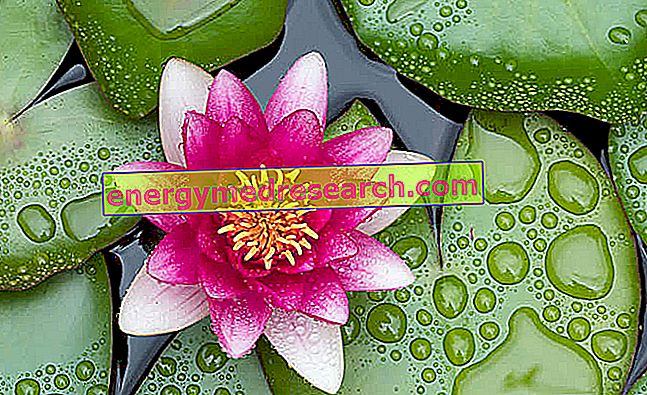Introduction
The lotus flower - considered sacred in Buddhism and Hinduism - is an aquatic plant belonging to the Nelumbonaceae family.
More precisely, within this family we can distinguish two different species:
- The Nelumbo nucifera, better known as Asian lotus flower, sacred lotus, or Indian lotus ;
- The Nelumbo lutea, better known as the American lotus flower .

Warning!
The lotus flower should not be confused with other aquatic plants, such as Nymphaea alba (commonly called "white lotus" or "white water lily") and Nymphaea caerulea (known with the common names of "blue lotus" or "Egyptian lotus" ).
It should be emphasized, however, that the Asian lotus flower and the blue lotus possess a similar chemical composition.
Indian Lotus Flower
The Indian lotus flower - sacred or Asian, if you prefer - is probably the best known species, since it is used in various fields, from food to cosmetic.
Features and Botany Description
The Indian lotus flower ( Nelumbo nucifera ) is a perennial aquatic herbaceous plant, native to India. It has a fleshy rhizome, creeping in the mud, and can reach two meters in height.
The leaves are carried on the surface of the water by long fistulous petioles longer than one meter. They are green, roundish, with entire margins, slightly wavy and with a diameter of 20-60 cm.
The flowers are solitary and possess a characteristic smell reminiscent of anise; they are carried over the leaves by long erect peduncles that far exceed the latter, pushing the flowers upwards, out of the water. The diameter of the flowers can reach 20 cm in size; the petals are pink in color with yellowish-white shades.
The fruits are woody ovoid nests inside which the seeds are enclosed.
The seeds of the lotus flower possess the particular characteristic of being able to remain viable for many years, if not centuries. Suffice it to say that, in 1994, an Indian lotus flower seed - dated around 1300 years - was able to germinate, thus giving rise to a new plant.
Curiosity
According to some researchers, the Indian lotus flower is able to regulate the temperature inside its flowers, just as the human body is able to regulate body temperature.
The researchers claim that this phenomenon is being implemented to attract pollinating insects even in cold climates.
Chemical composition
The drug of the Indian lotus flower consists of the roots, seeds and aerial parts of the flowering plant. The main chemical constituents are:
- Isoquinoline alkaloids, among which the nuciferine, the ramerina, the N-nornuciferin and the O-nornuciferin;
- Flavonoids, among which we find quercetin, isoquercetin, hyperoside and nelumboside;
- Tannins .
Properties of the Indian Lotus Flower
The Indian lotus flower is mainly attributed astringent properties, mainly attributable to nuciferine, ramerina and tannins, to which is added a refreshing action.
Furthermore, from animal studies, nuciferine has been shown to have a pharmacological profile similar to that of chlorpromazine (a phenothiazine used in the treatment of various disorders, such as psychosis, anxiety and intense pain).
Anti-inflammatory and antioxidant properties are ascribed to the plant's quercetin. Moreover, from in vitro studies it has emerged that this flavonoid - through the inhibition of catechol-O-methyl transferases - could be able to increase thermogenesis, favoring a possible weight loss. However, similar activities still need to be confirmed and need further investigation.
Given the numerous properties possessed by the substances contained in the Indian lotus flower, the research conducted on this plant has been many, in order to identify the possible applications in the medical field. For example, a study conducted on animals highlighted the potential antiepileptic properties of the lotus flower fruit; while another study confirmed the anti-inflammatory properties of the plant leaf extract. Finally, numerous other studies have shown that lotus flower extracts have the potential to exert an antitumor action against different types of human tumors, such as, for example, colon cancer.
However, despite the more than encouraging results obtained so far, further studies are needed and, at the moment, the use of the lotus flower or its derivatives is not approved for any type of therapeutic indication.
Uses of the Indian Lotus Flower
Currently, the main uses of the Indian lotus flower are in the cosmetic and culinary field, although the plant is still used in various popular medicines.
In cosmetics, Indian lotus flower extracts are used in various products, especially for their astringent and refreshing properties. However, according to some, these extracts would also be able to carry out a lipolytic action (an activity that has not yet been confirmed), therefore, they can be included in the composition of cosmetics against cellulite.
In the kitchen, instead, we use flowers, seeds, rhizomes and young leaves because they are all edible. In Asia, the larger leaves are used to wrap food, but it is also possible to use them - along with flowers - for making tea and infusions. The rhizomes are usually used as a condiment; while the roots are eaten fried.
Last but not least, the uses for ornamental purposes of the lotus flower which is specially cultivated in order to embellish ponds and ponds.
Use in folk medicine
By virtue of their astringent action, the powdered seeds of the Indian lotus flower are used by folk medicine as an internal remedy against diarrhea; while the flowers are used as an astringent remedy in the case of bleeding.
In Indian folk medicine, the lotus flower is used to treat gastrointestinal disorders (such as vomiting and diarrhea), to treat diseases such as cholera and intermittent fever, and to counter worm infestations.
Symbols of the Indian Lotus Flower
As mentioned, the lotus flower is considered sacred by both Hinduism and Buddhism. In fact, in the representations of the deities of both these religions the lotus flower is often present.
The Indian deities are depicted seated on large lotus flowers in the middle of the water, as they are depicted holding the flower of the plant in their hands.
In Buddhism, on the other hand, the lotus flower in a certain sense represents the Buddhist philosophy: the flower that rises above the water represents, in fact, the purity of the mind and of the body that floats above the waters and the roots that they sink into the mud of attachment and desire (two of the so-called five powers of the Buddha, in fact, are precisely the awareness of change and non-possessiveness).
Finally, in other Asian cultures, the lotus flower is considered a symbol of elegance, beauty, grace, perfection and purity.
American Lotus Flower
The American lotus flower ( Nelumbo lutea ) - commonly called " yellow lotus " - is also a perennial aquatic plant, with characteristics similar to those described for the Indian lotus flower. One of the aspects that mainly differentiates it from the latter is probably the color of the petals, which varies from white to pale yellow. The flowers, on the other hand, can reach rather large dimensions, ranging from 18 to 28 centimeters.
The American lotus flower is native to North America, Mexico, Honduras and the Caribbean, places where it grows in lakes and swamps.
Unlike the Indian lotus flower, for this species of American origin there are no known potential therapeutic properties, nor properties that can be exploited in cosmetics.
The interest in this lotus flower, therefore, is above all ornamental and alimentary, since it is also edible.
Curiosity
The two species of lotus flower - Nelumbo nucifera and Nelumbo lutea - have been crossed with each other in order to obtain hybrids, which are used both for ornamental purposes and for food purposes.



